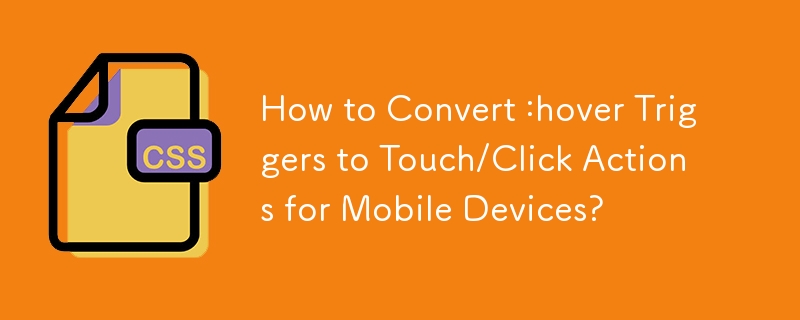Home >Web Front-end >CSS Tutorial >How to Convert :hover Triggers to Touch/Click Actions for Mobile Devices?
How to Convert :hover Triggers to Touch/Click Actions for Mobile Devices?
- Mary-Kate OlsenOriginal
- 2024-11-11 17:43:03238browse

Hover vs. Touch: Optimizing UI Interactions for Mobile Devices
In the world of web development, it's crucial to optimize user interactions across different devices. When working with :hover states for animations or dynamic content, the challenge arises on mobile devices where hovering is not applicable. In this article, we'll explore a solution to convert :hover triggers to touch/click actions on smaller screen sizes.
Addressing the Problem
As your code demonstrates, you have implemented a :hover animation using CSS transitions. However, on mobile devices, the :hover state is inaccessible due to the lack of a pointer device. This necessitates a workaround that activates the animation upon tap or click.
Solution Using CSS
Fortunately, CSS offers a straightforward solution using the :active selector. By combining it with :hover and ensuring :active is listed after :hover in the selector, you can achieve the desired behavior.
Code Implementation
The following code modification will resolve the issue:
.info-slide:hover, .info-slide:active {
height: 300px;
}
This code extends the :hover animation to apply to the :active state as well, which is triggered on touch or click events.
Testing and Confirmation
To verify this solution, it's recommended to test the FIDDLE in a mobile browser. Alternatively, you can use a browser developer tool to simulate touch events.
Conclusion
By leveraging the :active selector in conjunction with :hover, you can enable animations on mobile devices through touch or click interactions. This straightforward solution ensures that your website's user interface adapts seamlessly to different input methods.
The above is the detailed content of How to Convert :hover Triggers to Touch/Click Actions for Mobile Devices?. For more information, please follow other related articles on the PHP Chinese website!

